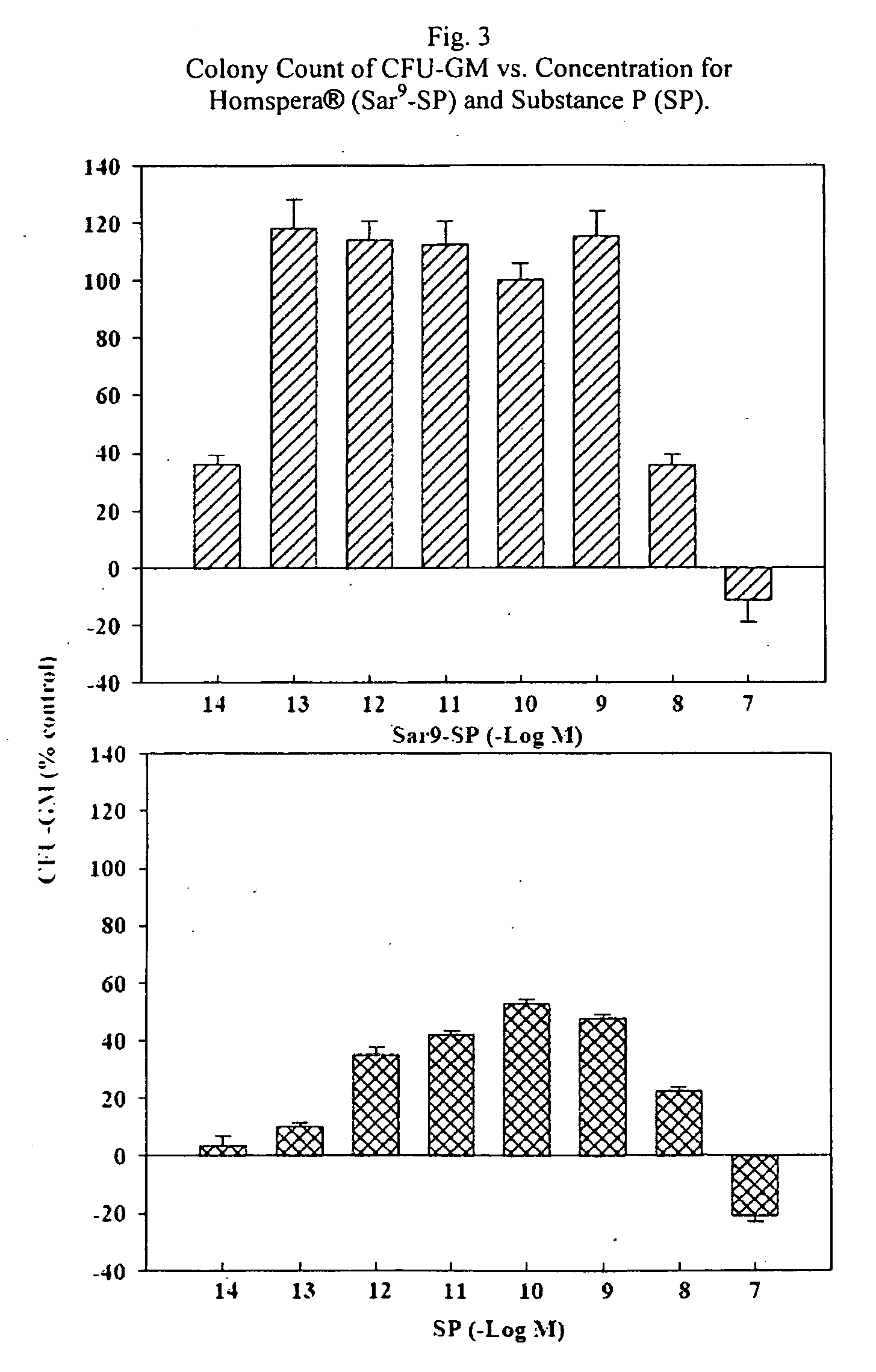Methods of treating blood cell depletion
a technology of blood cell depletion and treatment method, applied in the field of hematology, can solve the problems of severe myelosuppression, drug therapy must be discontinued, life-threatening, etc., and achieve the effect of reducing or ameliorating an adverse effect of a drug, reducing or ameliorating one or more adverse effects of a drug or a medication
- Summary
- Abstract
- Description
- Claims
- Application Information
AI Technical Summary
Benefits of technology
Problems solved by technology
Method used
Image
Examples
example 1
6.1 Example 1
Preliminary Analysis of Effects of a Substance P Analog Following Lethal Radiation of Mice
[0217]One purpose of the study is to determine the effects of Homspera® (formerly Radilex™; [Sar 9,Met (02) 11] Substance P) after exposure to a lethal dose of 60 Co radiation exposure. Another purpose of the study is to determine if intramuscular injections of Radilex™ can be as effective as aerosol inhalation of Radilex™ at 8Gy 60 Co radiation level.
[0218]Blood draws (2 animals per group rotating every 5 days) for erythrocytes, leukocytes and platelets were taken to assess anemia, neutropenia and thrombocytopenia. Counts of erythrocytes, leukocytes and platelets were taken to assess anemia, neutropenia and thrombocytopenia and act as indicators of bone marrow damage and / or immune system destruction.
[0219]The mice received Homspera® treatment within 2 hours of radiation exposure. The Homspera® dosage was administered in a volume of 0.01 ml in a daily single treatment via IM inject...
example 2
6.2 Example 2
Half-Life of Plasma Homspera® Relative to Native Substance P
[0234]The objective was to determine the half-life of Homspera® (RPKPQQFFMeGlyLM(O2)—NH2 (SEQ. ID. NO:10)) in plasma from three animal species.
[0235]Frozen plasma from mice, human and non-human primates (designated hereinafter as primates for simplicity) was obtained from Biochemed (Winchester, Va.) (human: Lot BC061107-07, primate: Lot CYNBREC-27070, mouse: Lot S-74242). EDTA was added as an anticoagulant during isolation of the plasma for all samples.
[0236]The plasma was thawed and 990 μL was added to a 1.5 mL microcentrifuge vial. To have a final concentration of Homspera® in the plasma, two different stock solutions at either 1 mg / mL or 10 mg / mL were prepared using phosphate buffered saline (PBS), pH 7.4 at a 1× concentration. Ten μL of a 1 mg / mL solution were added to 990 μL of plasma for a final Homspera® concentration of 7 μM and samples were vortexed to mix. Ten μL of a 10 mg / mL solution were added to 9...
example 3
6.3 Example 3
The Exemplary Substance P Analog Homspera® Stimulates Cellular Proliferation and Differentiation Following Radiation Treatment
[0242]This study was done to determine the effect of treating irradiated mice with an exemplary substance P analog.
6.3.1. Materials and Methods
[0243]Homspera® was provided by ImmuneRegen via CSBio, Inc. (Menlo Park, Calif., catalog number CS2663) as a lyophilized powder of the trifluoroacetate salt. The sample was stored at −20° C. until solubilized. Homspera® was dissolved in dilute sterile saline and dilute acetic acid to obtain a solution of 300 μM concentration.
[0244]Seventy-two (72) Balb / c mice of age 5-6 weeks and normal physiological state (Taconic) were separated into 4 groups: Non-irradiated control (or Non-treatment control) (n=12), Irradiated control (vehicle controls) (n=20), Irradiated / Treated pre-exposure (n=20), and Irradiated / Treated post-exposure (n=20). Animals were housed individually in ventilated microisolator cages (4-5 mice...
PUM
 Login to View More
Login to View More Abstract
Description
Claims
Application Information
 Login to View More
Login to View More - R&D
- Intellectual Property
- Life Sciences
- Materials
- Tech Scout
- Unparalleled Data Quality
- Higher Quality Content
- 60% Fewer Hallucinations
Browse by: Latest US Patents, China's latest patents, Technical Efficacy Thesaurus, Application Domain, Technology Topic, Popular Technical Reports.
© 2025 PatSnap. All rights reserved.Legal|Privacy policy|Modern Slavery Act Transparency Statement|Sitemap|About US| Contact US: help@patsnap.com



